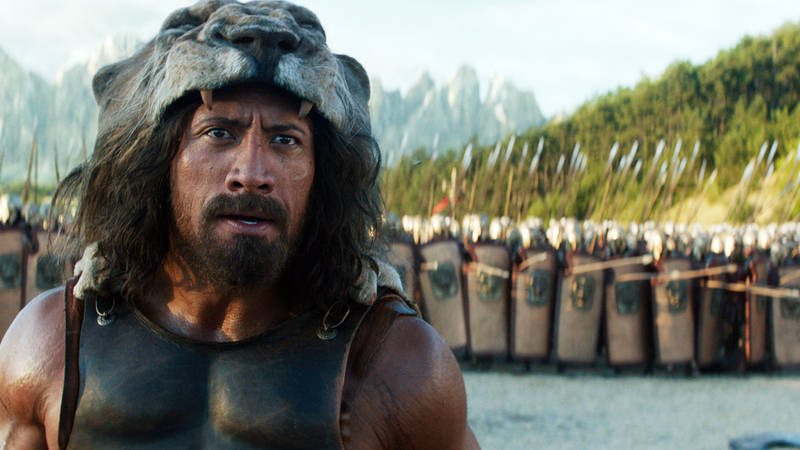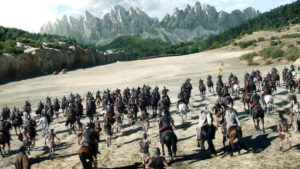
The Art of VFX: Hercules – Simon Stanley-Clamp
Last year, Simon Stanley Clamp talked to us in details about the Cinesite’s work on IRON MAN 3. He then supervised the visual effects of movies such as WORLD WAR Z, ROBOCOP and EDGE OF TOMORROW.
How did Cinesite get involved on this show?
We were subcontracted the sequence by Double Negative. Decisions for this sequence came late in the edit, while they were still determining the action. We initially took a briefing from DNeg supervisor Paul Franklin, before VFX Supervisor/Producer Dean Wright became our main contact with VFX Supervisor John Bruno.
How did you work with Production VFX Supervisors Dean Wright and John Bruno?
 We worked recently with VFX Supervisor/Producer Dean Wright on ROBOCOP and previously with VFX Supervisor John Bruno on X-MEN 2 and ALIENS VS PREDATOR. Initially, our contact was through Double Negative, who had subcontracted the work to us, but Dean and John became our main contacts for the significant portion of the post production.
We worked recently with VFX Supervisor/Producer Dean Wright on ROBOCOP and previously with VFX Supervisor John Bruno on X-MEN 2 and ALIENS VS PREDATOR. Initially, our contact was through Double Negative, who had subcontracted the work to us, but Dean and John became our main contacts for the significant portion of the post production.
What was their approach about the visual effects?
Initially, communication took place via cineSync on a weekly and bi-weekly basis and John came over for the final month before delivery. The clients signed off a layout of Cotys’ army advancing, with the flanks opening up into an arrow-head formation.Processes were compressed because the work was completed in a very short time frame, with standard animation, then blocking and greyscale reviews, then shots were worked up with lighting for compositing reviews.
What are the sequences made by Cinesite?
Our main sequence was the Rhesus Battle. We also completed a few shots of Cotys’ army at camp, in which we added the Mount Asticus environment to the background.
Can you describe to us one of your typical day?
Days were pretty long. I’d start around 8am, planning work for the day in Scratch and reviewing feedback received from the client. Targets for the day were posted on white boards for the team to see when they got in. During the morning we’d review lighting from the previous night’s renders, approving the best versions to go into the composites. Compositing dailies would also take place later in the morning, preparing shots for client review in the afternoon. Early afternoon would be spent giving one to one feedback to artists on shot development, constantly reviewing, absorbing and modifying shots. Client reviews took place later in the afternoon, then we’d relay the client feedback to artists, set up night renders for lighting and do a round up of where things stood at the end of the day.
What references and indications did you receive for your work?
We received set survey data, set reference photos, costume photos and HDRi for each shot setup.
What was the biggest challenge on this project and how did you achieve it?
We spent a great deal of time trying to get Goalem to work – it often felt like guess-work. In retrospect, hand animation would have been a more productive process in many cases. The compressed schedule was also a challenge, but one that we are used to rising to meet.
Was there a shot or a sequence that prevented you from sleep?
 The Centaurs were tricky. In several shots, we see a group of Centaurs silhouetted at the top of a hill. The fifth time we see them, we realize that they are not really Centaurs, but riders on horseback, seen from a fortuitous angle. VFX Supervisor John Bruno gave the direction that they should appear as an optical illusion, like something out of “Cirque du Soleil”. 3D modeling and hand animation was required for the capes and upper torsos of the principle riders, to ensure the horses’ heads are indistinguishable from the riders’ bodies. The clients knew what they wanted, but hadn’t tested the idea visually and we needed to come up with a way of making it work. Shot 300 was also a hurdle – it’s an entirely 3D shot with an advancing army storming over a hill, which came very late in the schedule. Because the render was so massive, we had few opportunities to get it right and programming the army with Goalem also had its challenges; thankfully, it worked out well and was delivered on the final day.
The Centaurs were tricky. In several shots, we see a group of Centaurs silhouetted at the top of a hill. The fifth time we see them, we realize that they are not really Centaurs, but riders on horseback, seen from a fortuitous angle. VFX Supervisor John Bruno gave the direction that they should appear as an optical illusion, like something out of “Cirque du Soleil”. 3D modeling and hand animation was required for the capes and upper torsos of the principle riders, to ensure the horses’ heads are indistinguishable from the riders’ bodies. The clients knew what they wanted, but hadn’t tested the idea visually and we needed to come up with a way of making it work. Shot 300 was also a hurdle – it’s an entirely 3D shot with an advancing army storming over a hill, which came very late in the schedule. Because the render was so massive, we had few opportunities to get it right and programming the army with Goalem also had its challenges; thankfully, it worked out well and was delivered on the final day.
How long have you worked on this film?
We received material mid-Feb, started work early in March and delivered on 4th July.
How many shots have you done?
180
What was the size of your team?
80
